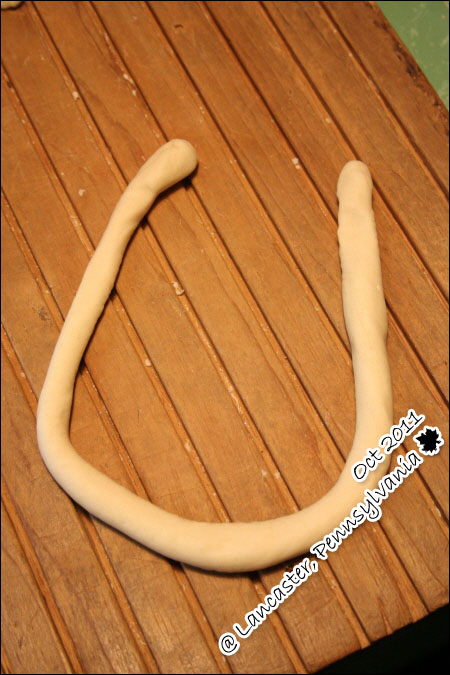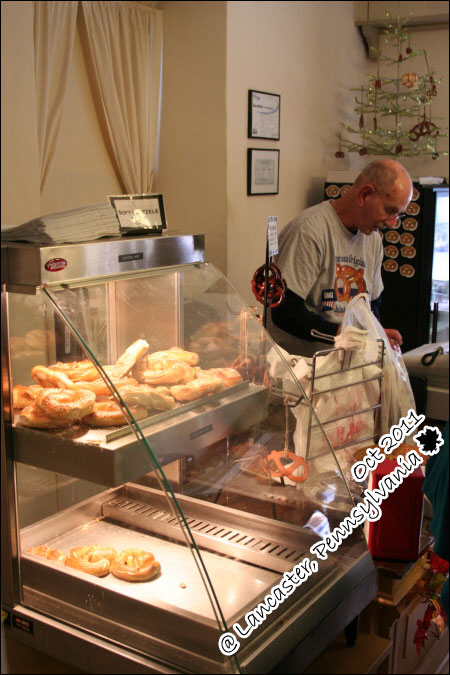I should tell you this.
You might be impressed :)
All four of my family members get the official pretzel twisting certifications from
the oldest pretzel bakery of America, Julius Sturgis Pretzel Bakery.
Have you heard about Julius Sturgis Pretzel bakery located in Lititz (close to Lancaster) PA?
It is the first bakery in America, they claimed.
Well, as the Julius Sturgis Pretzel Bakery is listed on the National Register of Historic Places,
I assume it's a correct information.
The bakery was founded in 1861,
exactly 150 years ago, in Lititz by Julius Sturgis, a bread baker from the town.
The 4 and 5th generation of the Sturgis family still run the business.
We found about this pretzel bakery tour in Lancaster town paper.
It sounded fun!
And as I am a baker myself, home baker though :),
I needed, or wanted, to see how a pretzel is made in a traditional way at a really really old bakery.
A tour started just 5 minutes before. Darn...
Well, but there is a tour every half hour.
It cost $3 for an adult, and $2 for a kid.
We first bought tour tickets before we came out of the historic building for a half hour, to see
another very old beautiful building cross the street.
Surprisingly the door was open!
Well, it was Columbus day.
Could it be a reason why the hall was completely vacant?
Stained glasses were artistic.
It reminded me of French cathedrals.
As the school is currently fully functional, there was no, or almost no room for a tour.
It was okay though.
It was almost time for Pretzel Twisting tour.
Lititz Moravian Church.
And then, we came back to the "fameuse" pretzel bakery.
Oh, by the way,
Julius Sturgis was the first baker who started to make hard pretzels in America where there had existed only soft pretzels.

These are over 100 years old baking equipment and tools.
The flour, water, and yeast was mixed to a fairly stiff consistency in the dough barrel above and left to rise overnight. The first risings was called "sponging"

Yeast maker or yeast container.
I asked the guide, and now they are using only dry yeast instead of fresh one.


These are over 100 years old baking equipment and tools.
The flour, water, and yeast was mixed to a fairly stiff consistency in the dough barrel above and left to rise overnight. The first risings was called "sponging"

Yeast maker or yeast container.
I asked the guide, and now they are using only dry yeast instead of fresh one.

The working space above is the "dough break"(?)
A bacon? of dough was place on this table for kneading. Each chunk of dough required 25 rides each way.
The bar Pablo is holding in the picture is the "ruler" to measure the length of a rope(or stick) of the dough.
Like this.
Each visitor was given a dough to try out a "pretzel twist."
Pablo rolled out his dough.
Then the guide showed us how to twist the rope to a "pretzel shape."
As you must have known it already,
but let me tell you what the Pretzel's unique shape means.
According to the legendary, in 7th century,
n Italian monk invented pretzels as a reward to children who learn their prayers.
He calls the strips of baked dough, folded to resemble arms crossing the chest, 'pretiola' ("little rewards")".
Well, it might be true.
But, the pretzel(brezel in German) is mostly eaten in southern Germany, not in Italy.
And also in some parts of the States as well.
I'll share the twisting skills I acquired at that tour :)
After you roll out the dough into 12 inches long
Make a U shape.
Then make a knot.
Then fold the upper part down to the circle beneath.
Then, tara~
It's ready to be baked.
But, this was not a real dough. It was only for practice.
Remi was watching carefully.
Pablso started knotting.
And we all received the certificate of Pretzel twisting :)
After the pretzels were twisted,
and before they were baked,
they were placed on these racks to rise for a while.
Once the pretzels were proven for the second time,
they were carried to the rear of the bakery to be baked~
Look at the ovens. Aren't they so real?
This is an old time oven.
As I said above, Julius Sturgis was the first "hard" pretzel baker in America.
After the ovens were preheated to a temperature of 550 F,
the pretzels that were to be made to hard pretzels were baked for 10 minutes then removed to the Kilns upstairs for drying and packaging, while soft pretzels were carried to the front shop to be sold.

In Montreal, very famous bagel shops still use exactly this type of oven.
If you want to see how to make Montreal bagel,
see my post here:
y
Remi wanted to keep the dough.
so he folded the dough carefully.
He kept just for less than an hour.
Then the pretzel machine was created in 1950s, which could replace 10 twisting men/women.
Since that time, the machine made "hard" pretzels have had similar shapes to the original twisted pretzels, but not really twisted if it is looked closely.
And these are hard pretzel molds.
But, of course, the soft pretzels are bread.
So they are to be handmade.
And there was a baker who demonstrated how to twist the pretzels.
She were very fast.
I may get faster if I can practice for a while :)
While hard pretzels were industrially made and distributed nation wide,
the soft pretzels that were made at the rear of the bakery are being sold in the front shop.
They were selling a tea towel with the explanation how to twist a pretzel.
But, it was almost $20.
I liked it a lot. But, to my standard, it was a bit too expensive for a tea towel.
So we just bough a couple of bags of hard pretzels before we left.
The tour was very nice interesting and engaging. :)
I'll post a pretzel recipe very soon.
Julius Sturgis Pretzel Bakery




































No comments:
Post a Comment